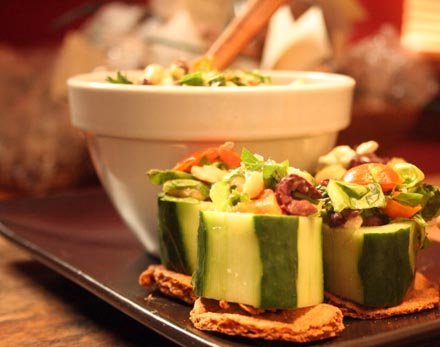
(Vegetarian, vegan option, gluten-free option)
It was B.Y.O.B.
A handful of friends – all expert wine drinkers with highly sophisticated palates – showed up at my house, each with a bottle of Beano and an enthusiasm that was heartening. Halfway though, my brother Joe showed up to deliver some farmer’s market goodies for my birthday (but more on the birthday next week). He got roped in too.
Our task: to taste our way through my current collection of heirloom beans. Sometimes, as with wine, the best way to really understand and deconstruct a flavor profile is by comparison. Besides, I was pressed for time, trying to compile tasting notes on all these guys since I’m attending the Seed Saver’s Exchange Convention in Iowa later this month.
And so we sniffed, we swirled, we held the beans up to the light. We studied their markings before and after cooking. We tasted them warm, then tasted them cool. We swallowed, then waited to see how the bean finished. Ridiculously attentive, we studiously sampled our way through nearly 30 varieties of heirloom bean in all.
The results? In a truncated version, here are some of the descriptors we found we could apply to members of the Phaseolus genus: waxy, meaty, mealy, creamy, sweet, sharp, herby, earthy, dusty, starchy, rich, chocolatey, peppery. We developed a whole lexicon for beans, borrowing a bit from wine tasting notes but mostly identifying very bean-centric characteristics.
I’ll bring you the full results soon enough, likely after I’ve returned from the Seed Saver’s Convention. For now, I’m sharing a recipe featuring what we almost unanimously crowned as the “best salad bean”.
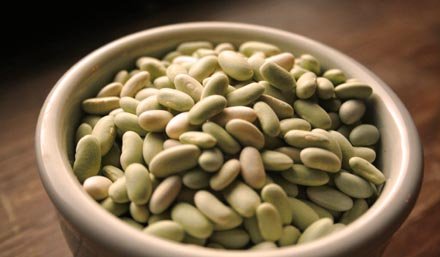
The green flageolet, also known as the flageolet vert, was first obtained by a French grower named Gabriel Chevrier, sometime between 1872 and 1878. This bean is set apart by its green color, which it holds onto even after the bean has dried in the pod. Though it is, technically, a white-seeded bean, it carries an odd ability to retain chlorophyll much longer than other beans. It maintains this pretty pale green shade even after it has been cooked.
Flavor wise, the bean is creamy and delicate and slightly starchy. Chameleon-like, it picks up the flavors of the foods it is cooked with, and so for this reason it would also make a good casserole or soup bean.
The Recipe
We liked the flageolet’s delicate freshness and its grassy flavor, and so to preserve this I cooked the beans alone and served them in a Mediterranean salad. That was only fitting, given the bean’s origins.
Plus, I had to do something with the cucumbers. My garden is teeming with them at the moment, and this appears to be just the beginning. Then there’s that one plant that I thought was a zucchini. It’s looking these days more and more like a third cuke. So, dear readers, those of you in similar bumper-crop straits can look forward to a series of recipes to help out.
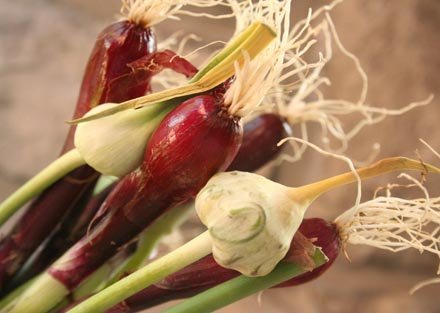
This pretty little salad is light and cool, a welcome escape from the heavy humidity that plagues our region during the mid-summer months. With oregano, parsley and a hint of mint, the flavor is invigorating and slightly exotic. The nasturtium leaves add a touch of pepper, for a salad that will leave you refreshed and awake.
A note about the dressing: You really want very little of it on this salad. Because everything is minced, in order to fit into a cucumber, more than 2-3 tablespoons would leave things soggy. I couldn’t figure out how to give a recipe that yielded that amount, so I hope you like the dressing because you’re going to have extra. It’s a light, citrusy vinaigrette, with a perfect oil-acid balance.
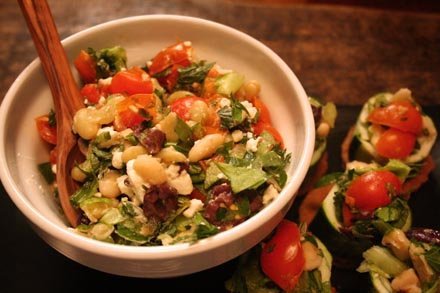
Greek Salad Stuffed Cucumbers with Toasted Salted Pitas and Green Flageolets
3 whole wheat Greek pita breads
2 tablespoons olive oil
salt
2 – 3 cucumbers
3 cups leaf mixed leaf lettuce and spinach, chopped finely
1/3 cup nasturtium leaves and/or flowers (optional)
1 cup of cherry tomatoes, quartered
1/3 cup kalamata olives, chopped
2 tablespoons fresh Greek oregano, minced
2 tablespoons fresh parsley, minced
1 tablespoon fresh mint, minced
1 cup green flageolets (you may substitute great northern beans)
4 ounces imported Greek feta cheese, crumbled
3 tablespoons fruity extra-virgin olive oil
1 tablespoon fresh lemon juice
2 tablespoons red wine vinegar
1 spring onion bulb
1 teaspoon spring garlic, minced and bruised
black pepper to taste
* you will likely not need salt, since the kalamatas and the feta are sodium-rich, but that’s your call
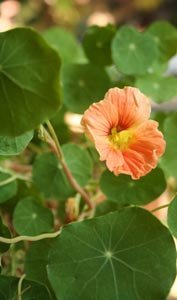
Preheat the oven to 375. If you have one, do this in a toaster oven to reduce kitchen heat.
Using a biscuit or cookie cutter or an empty tomato paste can, cut pitas into 1 ½ inch rounds. With a brush, lightly oil them on both sides and then dust them with salt. Place on a tray and bake until they are crispy, about 12 minutes, turning once halfway through.
Using a peeler, create stripes on the outside of the cucumber by peeling strips along length of cucumber, leaving every other section of skin intact. Remove the ends of cucumbers and slice them into 1-inch rounds. Using a melon baler or a small spoon, scoop out the seeds and inner flesh from the top 2/3′s of each cucumber slice, being careful not to scrape through the bottom.
Place chopped salad greens, kalamatas, tomatoes, oregano, parsley and mint in a bowl and toss to mix. Add green flageolets and feta, and toss again lightly, being careful not to mush beans or cheese.
In a bottle, combine olive oil, lemon juice, red wine vinegar and pepper. Shake well. Drizzle two to three tablespoons over the salad and stir lightly.
Using a spoon, scoop salad mixture into the hollowed cucumber slices. Place cucumber slices on pita rounds and serve.
